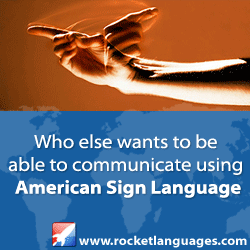A deaf persons name, signed, is music to their eyes
0There is no better music in the world, than when you sign a deaf person’s NAME
Not everyone knows exactly what to do when they encounter a deaf person. Whether it’s in your favorite neighborhood café, inside your office, in one of your classrooms, or down the street, the reality is that you can encounter deaf people anywhere. When you do, the last thing you want to happen is for you to feel all awkward because you don’t know what to do.
Because they have hearing difficulties, deaf people communicate in a way that’s entirely different from how you would do it. Don’t be mistaken in thinking that all deaf individuals communicate in exactly the same way either. Knowing American Sign Language (ASL) would come in handy, but it’s not the only way the deaf communicate.
Communicating with Deaf People
One important thing that you should understand is that there are varying kinds of deafness. Some are just hard of hearing, some are profoundly deaf, and some are completely deaf. Some are deaf from birth, while some may have lost their hearing somewhere along the way. Some will be able to read your lips and understand what you’re saying, while some will need sign language.
This means that communicating with deaf people is not as straightforward as you think it is. But like any other individual, a deaf person would want to be heard and would want to understand you as well. While communicating with deaf people will take some extra effort on your part, once you get the hang of it, you will find the experience rewarding.
When communicating with the deaf, there are a few things you must remember:
- Sign their Name
A name is a big part of a person’s identity, and for those of us who have no hearing problems, it’s easy to take this for granted. When you call someone by name, it immediately connects you to that person on a personal level, and this is imperative for good communication. In the same way, it’s important for us to include the Deaf by learning to speak to them on a personal level.
Once you go on a journey of learning ASL, knowing how to sign the name of your deaf relative, friend, or loved one is a very good place to start. This will put you on a very personal plane with them, and set the stage for open communication and trust. There is no better music in the world that you could play for them than when you sign their name.
- Make eye contact.
In any conversation, even if it’s not with a deaf person, eye contact is always critical because it shows that you’re fully there in the moment and that you’re mentally invested. When communicating with a deaf person, it is, of course, important to get his or her attention first, before you begin any conversation. You need to speak eye to eye and ensure that your face is in a good light, with your mouth entirely visible.
As the conversation moves along, it’s important that you stay in the person’s field of vision. Your eyes should always be on the same level (whether sitting or standing), and you should be about 1-2 meters away, just a tad further than normal speaking distance.
- It’s not just about the hands.
Your hands are not the only body part you can use when communicating with the deaf. Yes, your hands are an important part of American sign language, but there’s so much more beyond that. Speaking clearly is another one because many deaf people can lip-read. It’s also the perfect time to make use of your facial expressions. Your face here can serve as a blank canvas where the emotions related to your topic can be reflected. Body language is another thing you can rely on. You can also use visual cues and objects that can help you communicate your point well.
- Speak at a natural pace and in your normal tone.
When you’re with a deaf person you have to be considerate and extra clear about what you’re trying to say. Some people make the mistake of speaking too fast, to the point that the deaf person will find it difficult to lip-read. That said, never overdo it.
There’s also this danger that people speak too slow when with a deaf person, trying to overcompensate. Instead of being considerate, it will seem like you’re patronizing the person you’re talking to, which isn’t good and can sometimes seem even insulting. What you should do is just relax and speak at a natural pace, but always make sure you’re understood before continuing.
- Stick to one topic at a time.
Before you start talking and talking, you need to make sure that the deaf person is clear about what your topic of conversation is. It will be easier for him or her to follow the natural flow of the conversation if the topic is made clear from the very beginning. Don’t make the mistake of jumping from one topic to another, because it will be hard for them to follow you.
Things You Should Never Say or Do
Not everyone has experience in communicating with the deaf community, so once you start doing so, it’s sometimes challenging in the sense that you don’t always know exactly what to do. It’s also important to remember that communication is not just about what you’re saying but HOW you’re saying it. Learning sign language, therefore, is not just about the basics of the language per se but also involves a lot of cultural aspects.
Here are some things you should never say or do when communicating with the deaf community:
- Don’t over-exaggerate your tone of voice or the way you speak, because this will also distort your lip patter.
- Don’t shout. This makes your face and mouth unreadable and can be very uncomfortable (even painful) for those wearing hearing aid.
- Don’t jump to another topic without adequate warning.
- Don’t congratulate the deaf person for being so ‘smart’, and don’t say you’re sorry about his or her condition.
- Don’t give up even if it seems hard.

